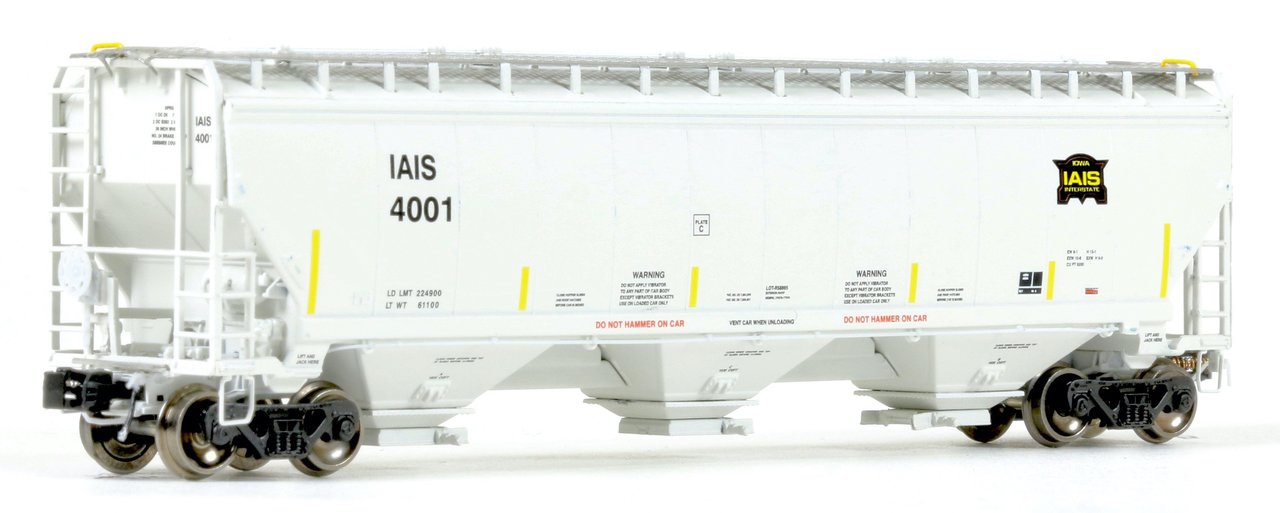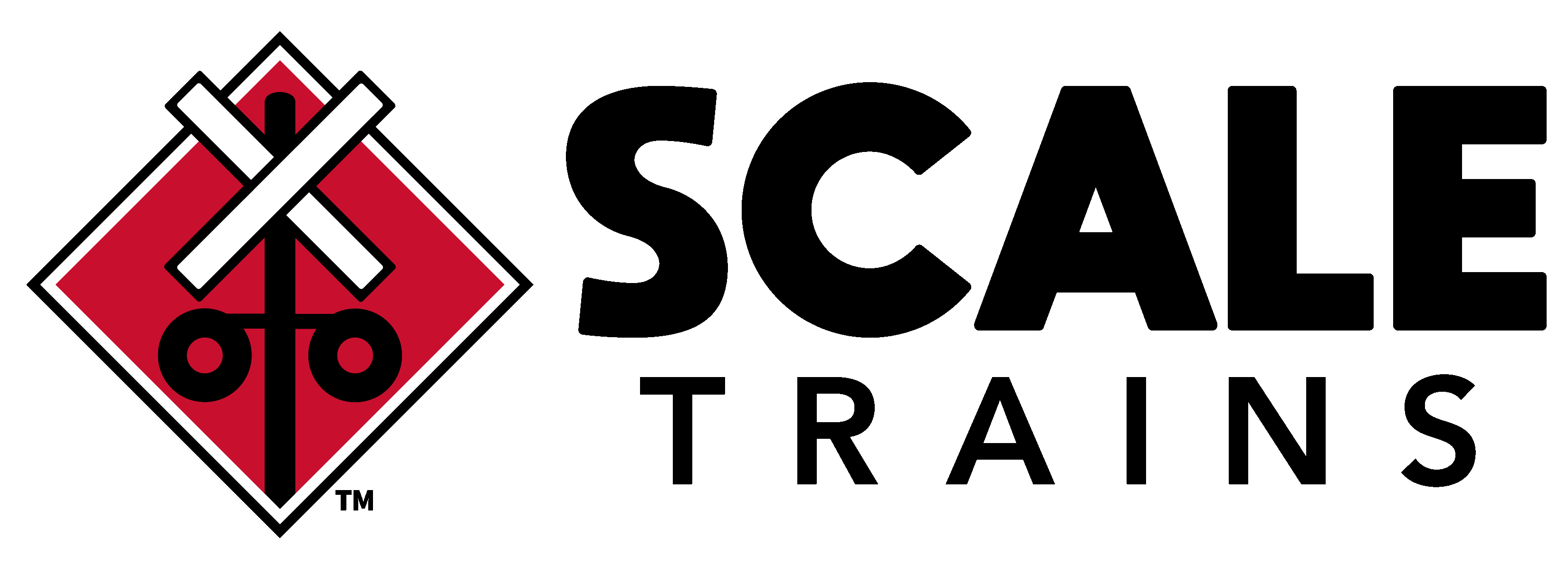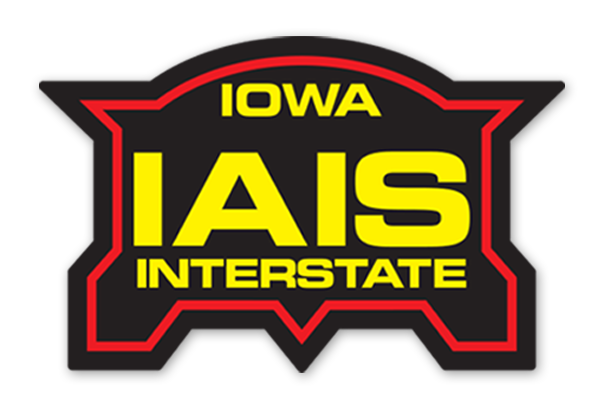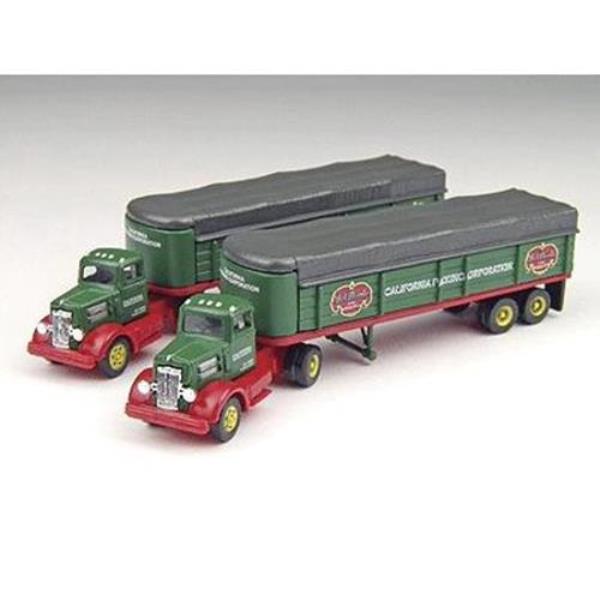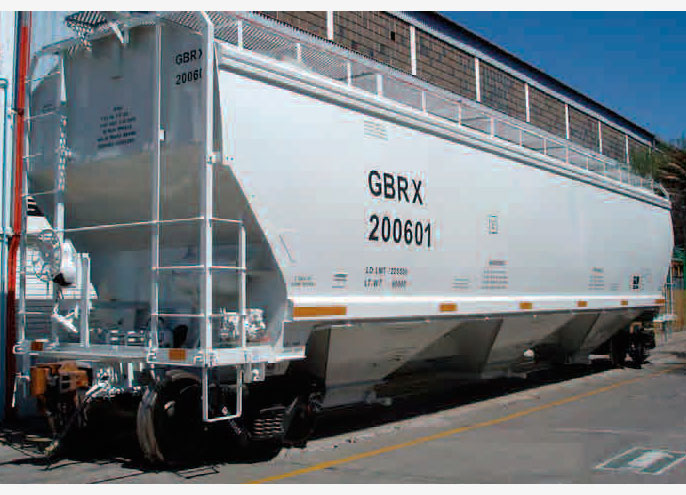Model Information: ScaleTrains first announced this model in early 2018 and first delivered it in October of 2018. It is a highly detailed model of a 4-bay covered hopper car. It features:
Up to 22 different road numbers;
Photo-etched stainless steel see through roofwalk with metal grab irons;
Photo-etched stainless steel see through end platforms;
Factory-applied trainline pipe;
Separately applied brake cylinder and linkage, control valve, air reservoir.;
Brake wheel, stand, and chain;
Plastic semi-scale Type E lower knuckle couplers – Micro-Trains® compatible;
ASF Ride Control trucks with finely rendered raised foundry data;
Minimum radius: 9 ¾”;
Recommended radius: 11”;
Photo etched stirrup steps;
Body mounted coupler box that can accept Micro-Trains® 1015/1016 type couplers.
Prototype History: Grain and grain products are one of the leading commodities hauled by railroads today. Typically carried in covered hoppers, designs have evolved over the years to increase the efficiency of handling this vital commodity. One of the more popular designs to emerge in recent years is the Gunderson-GIMSA/Concarril 5188cf Covered Hopper. Car Height, extreme: 15’ 6”. Length, over couplers: 52’ 10 1/8”. Cubic Capacity: 5,188 cu. ft.. Light weight: 62,000 lbs.
The Gunderson 5188cf is a large 3-bay hopper that measures 58’ over the coupler centers and is built to fit within the Plate C clearance diagram. These all-steel cars feature a capacity of 5,188 cubic feet and are equipped with trough-style loading hatches for efficient loading. The hatch covers can either be made of metal or non-metal materials depending upon customer specifications. Each of its three bays features a 30” x 30” outlet opening, which can be outfitted with a variety of outlet types depending upon customer requirements and/or commodities to be handled.
With the production of these cars starting in 2007, they have gone through several design changes including the quantity and width of panels used to construct the car sides, addition of two or four large horizontal ribs on the car sides, and placement and design of pulling loops.
From ScaleTrains.com
The Gunderson 5188cf is a large 3-bay hopper that measures 58’ over the coupler centers and is built to fit within the Plate C clearance diagram. These all-steel cars feature a capacity of 5,188 cubic feet and are equipped with trough-style loading hatches for efficient loading. The hatch covers can either be made of metal or non-metal materials depending upon customer specifications. Each of its three bays features a 30” x 30” outlet opening, which can be outfitted with a variety of outlet types depending upon customer requirements and/or commodities to be handled.
With the production of these cars starting in 2007, they have gone through several design changes including the quantity and width of panels used to construct the car sides, addition of two or four large horizontal ribs on the car sides, and placement and design of pulling loops.
From ScaleTrains.com
Road Name History: The Iowa Interstate launched in 1984 to operate the former Rock Island mainline from Chicago to Omaha with a few short branches, and one longer branch to Peoria. The mainline also serves the Quad Cities and Des Moines along the way. Cedar Rapids is served by agreement with Cedar Rapids & Iowa City. This Rock Island route had been operated by the Iowa Railroad between 1981 and the establishment of the IAIS in ‘84. Chicago to Bureau is on trackage rights and the western terminal is actually in Council Bluffs with Omaha just over the state line. In total, the system is 580 miles. IAIS’s parent company is Railroad Development Corp.
Early operations were mostly handled by the usual spin-off suspects, rebuilt first generation EMD road switchers. Of the 36 engines, only 3 GP38’s and an Alco RS-36 were 2nd generation units. As traffic picked up over the years, they began to dump the first generation road switchers in favor of used 4 axle 2nd generation power. Now many of those have been returned and Iowa Interstate is going ultra-modern. As of this writing, their 44 engine fleet consists of: 12 ES44AC “GEVO”’s; 8 SD38-2’s; 22 GP38-2’s 1 GP38; and a pair of slugs.
They also have a pair of Chinese built 2-10-2 steam locomotives used for tourists and special events. They can also be found in freight service to break them in after shopping.
The addition of the 12 brand new GEVO’s permitted IAIS to retire twice that number of older 2nd generation road switchers, and still have a net increase of pulling power. Two of these GEVO’s wear Rock Island heritage colors.
In addition to the usual Midwestern mixed-manifest freights, IAIS has a respectable intermodal business. In the early years, this consisted of a single 5-unit Twinstack behind a GP9 (really!) As of this writing, IAIS sports its own fleet of Maxi-IV stack cars among others, and trailers and containers now move in sizable blocks.
Early operations were mostly handled by the usual spin-off suspects, rebuilt first generation EMD road switchers. Of the 36 engines, only 3 GP38’s and an Alco RS-36 were 2nd generation units. As traffic picked up over the years, they began to dump the first generation road switchers in favor of used 4 axle 2nd generation power. Now many of those have been returned and Iowa Interstate is going ultra-modern. As of this writing, their 44 engine fleet consists of: 12 ES44AC “GEVO”’s; 8 SD38-2’s; 22 GP38-2’s 1 GP38; and a pair of slugs.
They also have a pair of Chinese built 2-10-2 steam locomotives used for tourists and special events. They can also be found in freight service to break them in after shopping.
The addition of the 12 brand new GEVO’s permitted IAIS to retire twice that number of older 2nd generation road switchers, and still have a net increase of pulling power. Two of these GEVO’s wear Rock Island heritage colors.
In addition to the usual Midwestern mixed-manifest freights, IAIS has a respectable intermodal business. In the early years, this consisted of a single 5-unit Twinstack behind a GP9 (really!) As of this writing, IAIS sports its own fleet of Maxi-IV stack cars among others, and trailers and containers now move in sizable blocks.
Brand/Importer Information: ScaleTrains.com, Inc. is an upstart HO and N Scale model manufacturer that was founded by a team with more than 125 years of accumulated experience in the model railroad hobby and industry.
ScaleTrains is specifically focused on the tiny details in the printing and quality of the construction. The four friends who founded the company are all avid modelers themselves. Their factory is located in Tennessee. Unlike most other companies, they offer a range of different levels of complexity in their offerings so as to be able to provide products for both the budget-conscious collector as well as the detail-focused model enthusiast without compromising on quality for either.
They range covers the following, by increasing level of detailing:
ScaleTrains is specifically focused on the tiny details in the printing and quality of the construction. The four friends who founded the company are all avid modelers themselves. Their factory is located in Tennessee. Unlike most other companies, they offer a range of different levels of complexity in their offerings so as to be able to provide products for both the budget-conscious collector as well as the detail-focused model enthusiast without compromising on quality for either.
They range covers the following, by increasing level of detailing:
- Operator™ trains are built for modelers who enjoy running high-quality, realistic trains at an affordable price. Designed from builder’s drawings and photographs, Operator models have fewer factory-applied parts and simplified printing. For added versatility, super-detail parts are available separately.
- The Rivet Counter™ line strives to create the most accurately detailed models imaginable. The real-world counterpart is meticulously researched to ensure prototype fidelity. Each model features numerous factory applied parts including roadname and road number specific details whenever possible.
- Museum Quality™ models are historically accurate replicas of the most famous locomotives in North American railroading history. Exhaustive research and a commitment to perfection combine to create the ultimate scale model. Museum Quality trains establish new standards which make them just as legendary as the original.
Item created by: Jenna on 2019-08-07 17:19:30
If you see errors or missing data in this entry, please feel free to log in and edit it. Anyone with a Gmail account can log in instantly.
If you see errors or missing data in this entry, please feel free to log in and edit it. Anyone with a Gmail account can log in instantly.


